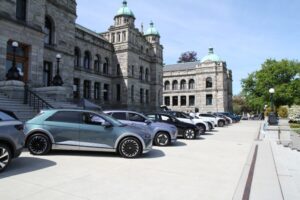By Blair Qualey
Last week, BC’s New Car Dealers Association hosted its annual EV Day at the Legislature to celebrate the progress of zero emission vehicles adoption in this province. The event is an annual coming together of industry leaders, policymakers, and stakeholders to mark success and hold hybrid Association and Foundation Annual General Meetings to discuss the important challenges facing the sector.
On the front steps of the BC Legislature, new car dealers were joined by the Premier David Eby, the Honourable Josie Osborne, Minister of Energy, Mines, and Low Carbon Innovation, and several other elected members to celebrate the progress of zero emission vehicle adoption in British Columbia. A record number of dealerships came together to showcase the latest advancements in EV technology and their collective display demonstrated the important work they do in increasing consumer awareness and adoption of electric vehicles.
The Annual General Meetings served as a platform to celebrate industry achievements in 2023. It also provided an opportunity to express gratitude to outgoing Board members James Carter, Peter Heppner, Erik Jensen, Anthony Lunelli, Peter Sia and Peter Trzewik for their years of dedicated service to BC franchised New Car Dealers. Their contributions have been instrumental in shaping the direction and impact of our association, and their presence will be missed. At the same time, we also extended a heartfelt welcome to new members, April Gaskell from GM Financial, Bradley Warren from BMO, and dealers Dave Bare from the Harris Auto Group on Vancouver Island, and Luke McClellan who is Managing Partner of Wheaton Chevrolet Ltd., Wheaton Buick GMC Ltd., and Mercedes-Benz Kamloops.
The AGM also served as an opportunity to discuss challenges facing our sector, the most notable being the zero-emission mandate, associated hard targets and penalty structure – in the face of softening demand. A recent national survey conducted by AutoTrader has shown that in the past two years enthusiasm for purchasing electric vehicles has seen a notable decline, dropping from 68% in 2022 to 56% by early 2024. This downward trend is concerning, in light of government mandates stipulating that 90% of light-duty vehicle sales in the province must be zero-emission vehicles (ZEVs) by 2030 and 100% by 2035.
It’s clear there are challenges on the horizon for the automotive sector, and we need to be adaptive and flexible to changing circumstances.
There is no doubting that our industry and government share the same desire; to create an environment that will assist BC in maintaining a leadership position in ZEV adoption. Where we differ is how to chart the most successful path. There is power in collaboration when industry and government unite in pursuit of a common goal – and that is something we hope to achieve.
The journey towards a sustainable automotive future is ongoing, but with each milestone reached and every partnership forged, we move one step closer to realizing a cleaner, greener tomorrow for our country.
Blair Qualey is President and CEO of the New Car Dealers Association of B.C. You can reach him at [email protected]











